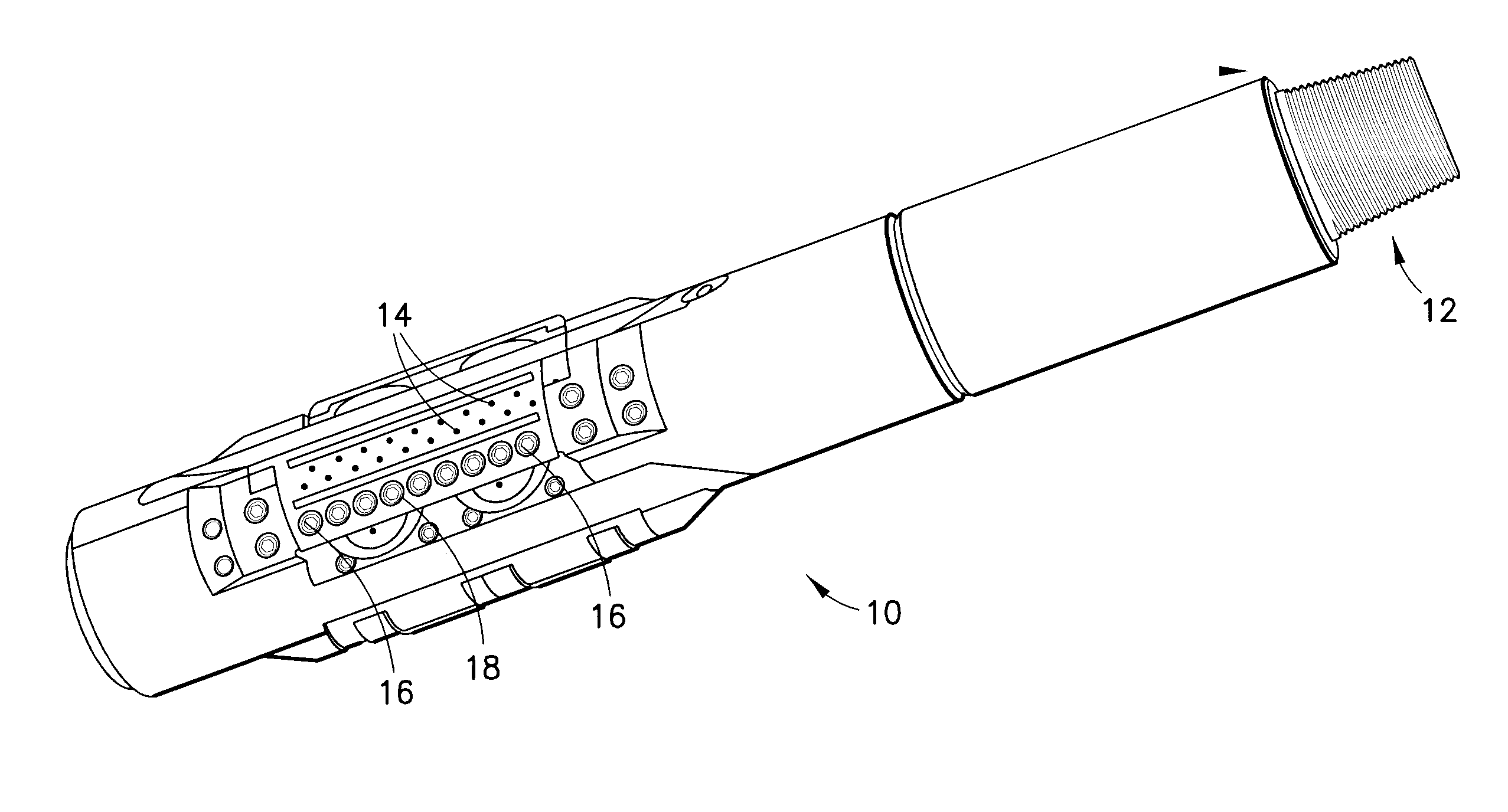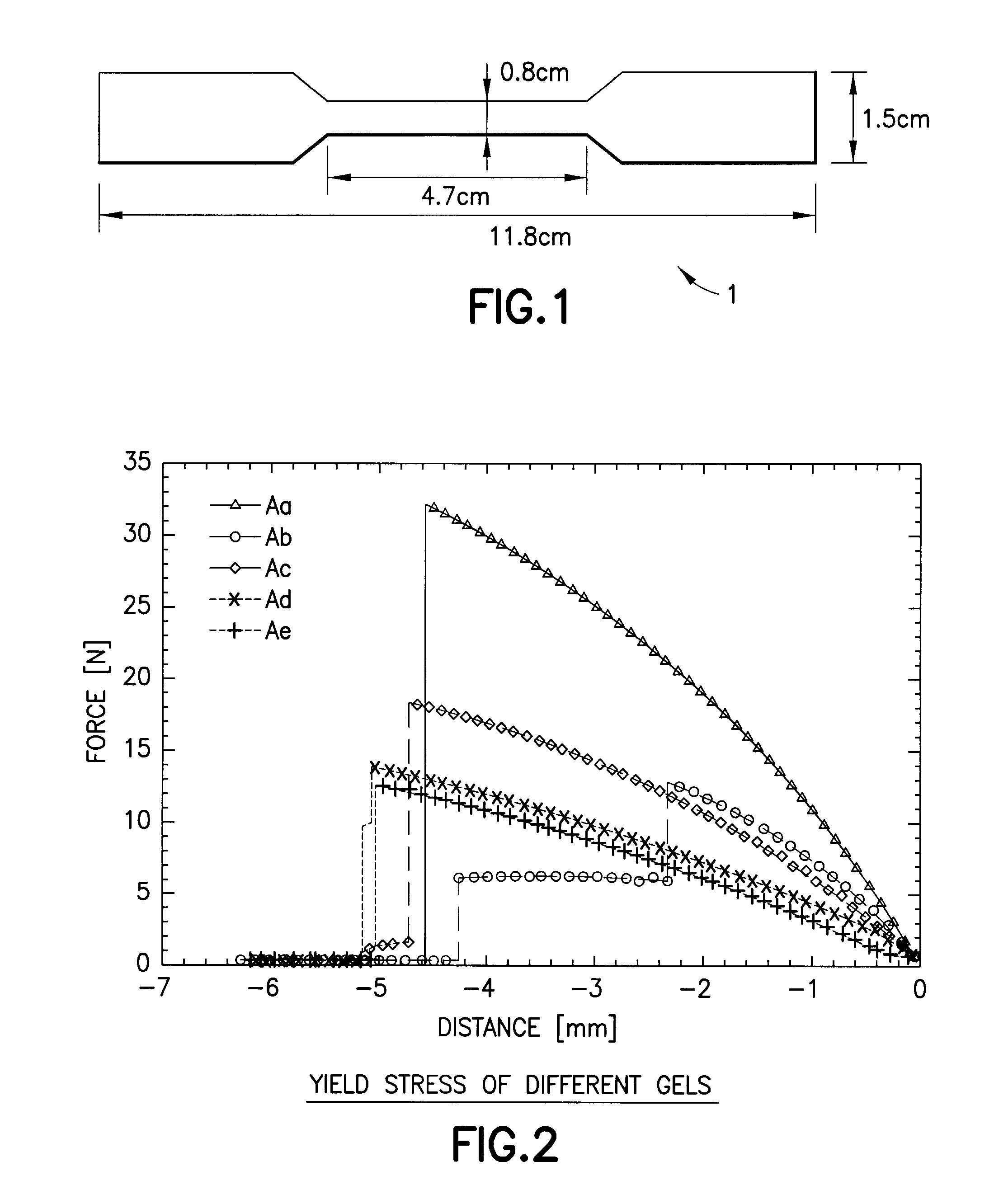Open-hole wellbore lining
a wellbore and wellbore technology, applied in the direction of wellbore/well accessories, sealing/packing, coatings, etc., can solve the problems of damage to the wellbore, negative economic impact, softening and disintegration of the wellbore wall,
- Summary
- Abstract
- Description
- Claims
- Application Information
AI Technical Summary
Benefits of technology
Problems solved by technology
Method used
Image
Examples
example 1
[0075]Acrylate type resins In this example the liquid composition includes components A, B, C and D:[0076]A) bisphenol A ethoxylate diacrylate (BAED)[0077]B) trimethylolpropane triacrylate (TPT)[0078]C)[0079]i. poly(ethylene glycol) diacrylate (PEGD) molecular weight 260;[0080]ii. poly(ethylene glycol) diacrylate (PEGD) m wt. 700;[0081]iii. poly(ethylene glycol) diacrylate (PEGD) m wt. 575;[0082]iv. 1,6-hexanedioldiacrylate (HDD);[0083]v. poly(ethylene glycol) dimethacrylate m wt. 330 (PEGDM)[0084]D) may be a photoinitiator ˜10 drops 2-hydroxy-2-methyl-propiophenone.
TABLE 1Acrylate based resins compositionsComponent AProduct BComponent CFormulation(15 g)(0.5 g)(5 g)AaBAEDTPTPEGD 260AbBAEDTPTHDDAcBAEDTPTPEGD 700AdBAEDTPTPEGDM 330AeBAEDTPTPEGD 575BaBAEDTPTMPEGD 260
[0085]These compositions produced hard, strong, quite brittle resins. FIG. 2 depicts tensile test data for Series Aa:Ae.
[0086]If desired, the resins can be reinforced with fillers such as clay, two examples were used: clay 1...
example 2
[0088]Divinyl ether type resins In this example, the compositions include component A, component B (cf. table 2) and C photoinitiator.[0089]A. TEGDVE: tri(ethylene glycol) divinyl ether 98%[0090]B.[0091]a. DEGDGE: di(ethylene glycol) diglycidyl ether[0092]b. GDGE: Glycerol diglycidyl ether[0093]c. NGDGE: Neopentyl glycol diglycidyl ether[0094]d. PPGDGE: Polypropylene glycol diglycidyl ether[0095]e. BDGE: 1,4-butanediol diglycidyl ether[0096]C. Photoinitiator: triarylsulfonium hexafluorophosphate salts, mixed 50% in propylene carbonate. 5:10 drops
TABLE 2Divinyl ether based resins formulationsFormulationComponent AComponent BB2aTEGDVEGDGEB2bB3aTEGDVENGDGEB3bB4bTEGDVEPPGDGEB5aTEGDVEBDGE
[0097]These formulations produced resins that ranged quite widely in softness and elasticity. Resin B1 was too soft to test in tensile mode. FIG. 5 shows tensile tests on samples of the other formulations, some in duplicate (B2, B3.).
example 3
[0098]Vinyloxybutylbenzoate type resins. In this example the compositions include the photoinitiator C, component A and one of the components listed in B.[0099]A. 4-vinyloxybutylbenzoate[0100]B. di or trivinyl ether, such as:[0101]a. bis[4(vinyloxy)butyl]succinate[0102]b. bis[4(vinyloxy)butyl]isophtalate[0103]c. tris[4(vinyloxy)butyl]trimellitate[0104]C. photoinitiator: triarylsulfonium hexafluorophosphate salts, mixed 50% in propylene carbonate (5-10 drops).
[0105]The component concentrations A and B were varied in ratio 2:1, 5:1, 10:1. Softer more elastic gels, with more rapid curing than acrylate type resins were obtained. FIG. 6 summarises test data for 2:1 ratios.
[0106]Other examples Other examples include Styrene-polybutadiene-styrene block copolymer dispersed in xylene at approximately 4 g / l, the reaction being initiated by 2-hydroxy-2-methyl-propiophenone or the triarylsulfonium hexafluorophosphate salts (50% in propylene carbonate). Both achieved a cure of a sticky gel, in 2...
PUM
 Login to View More
Login to View More Abstract
Description
Claims
Application Information
 Login to View More
Login to View More - R&D
- Intellectual Property
- Life Sciences
- Materials
- Tech Scout
- Unparalleled Data Quality
- Higher Quality Content
- 60% Fewer Hallucinations
Browse by: Latest US Patents, China's latest patents, Technical Efficacy Thesaurus, Application Domain, Technology Topic, Popular Technical Reports.
© 2025 PatSnap. All rights reserved.Legal|Privacy policy|Modern Slavery Act Transparency Statement|Sitemap|About US| Contact US: help@patsnap.com



